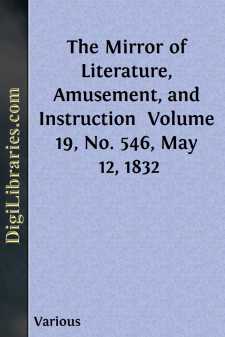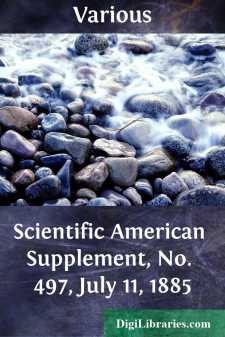Categories
- Antiques & Collectibles 13
- Architecture 36
- Art 48
- Bibles 22
- Biography & Autobiography 813
- Body, Mind & Spirit 142
- Business & Economics 28
- Children's Books 15
- Children's Fiction 12
- Computers 4
- Cooking 94
- Crafts & Hobbies 4
- Drama 346
- Education 46
- Family & Relationships 57
- Fiction 11828
- Games 19
- Gardening 17
- Health & Fitness 34
- History 1377
- House & Home 1
- Humor 147
- Juvenile Fiction 1873
- Juvenile Nonfiction 202
- Language Arts & Disciplines 88
- Law 16
- Literary Collections 686
- Literary Criticism 179
- Mathematics 13
- Medical 41
- Music 40
- Nature 179
- Non-Classifiable 1768
- Performing Arts 7
- Periodicals 1453
- Philosophy 64
- Photography 2
- Poetry 896
- Political Science 203
- Psychology 42
- Reference 154
- Religion 513
- Science 126
- Self-Help 84
- Social Science 81
- Sports & Recreation 34
- Study Aids 3
- Technology & Engineering 59
- Transportation 23
- Travel 463
- True Crime 29
The Mirror of Literature, Amusement, and Instruction Volume 19, No. 546, May 12, 1832
by: Various
Categories:
Description:
Excerpt
ST. PANCRAS (OLD) CHURCH.
ST. PANCRAS (OLD) CHURCH.This humble village fane is situated to the north of London, somewhat more than a mile from Holborn Bars. Persons unacquainted with the site, may hitherto have considered it as part and parcel of this vast metropolis: but, lo! here it stands amidst much of its primitive, peaceful rusticity.
Pancras is still, by courtesy, called a village, though its charms may be of the rus-in-urbe description. It derives its name from the saint to whom the church is dedicated: it was called St. Pancras when the Survey of Domesday was taken. The parish is of great extent. Mr. Lysons states it at 2,700 acres of land, including the site of buildings. It is bounded on the north by Islington, Hornsey, and Finchley; and on the west by Hampstead and Marybone. On the south it meets the parishes of St. Giles's in the Fields, St. George the Martyr, St. George, Bloomsbury, and St. Andrew's, Holborn. On the east it is bounded by St. James's, Clerkenwell. Kentish Town, part of Highgate, Camden Town, and Somer's Town, are comprised within this parish as hamlets. Mr. Lysons supposes it to have included the prebendal manor of Kentish Town, or Cantelows, which now constitutes a stall in St. Paul's Cathedral. Among the prebendaries have been men eminent for their learning and piety: as Lancelot Andrews, bishop of Winchester, Dr. Sherlock, Archdeacon Paley, and the Rev. William Beloe, B.D. well known by his translation of Herodotus.
It would occupy too much space to detail the progressive increase of this district. When a visitation of the church was made in the year 1251, there were only forty houses in the parish. The desolate situation of the village in the latter part of the sixteenth century is emphatically described by Norden, in his Speculum Britanniæ. After noticing the solitary condition of the church, he says, "yet about this structure have bin manie buildings now decaied, leaving poore Pancras without companie or comfort." In some manuscription additions to his work, the same writer has the following observations:—"Although this place be, as it were, forsaken of all; and true men seldom frequent the same, but upon devyne occasions; yet it is visyted by thieves, who assemble there not to pray, but to wait for praye; and manie fell into their handes, clothed, that are glad when they are escaped naked. Walk not there too late." Newcourt, whose work was published in 1700, says that houses had been built near the church. The first important increase of the parish took place in the neighbourhood of Tottenham Court Road.
"Pancras Church," says Norden, "standeth all alone, as utterly forsaken, old and wether-beten, which, for the antiquity thereof, it is thought not to yield to Paules in London." It is of rude Gothic architecture, built of stones and flints, which are now covered with plaster. Mr. Lysons says, "It is certainly not older than the fourteenth century, perhaps in Norden's time it had the appearance of great decay; the same building, nevertheless, repaired from time to time, still remains; looks no longer 'old and wether-beten,' and may still exist perhaps to be spoken of by some antiquary of a future century....












